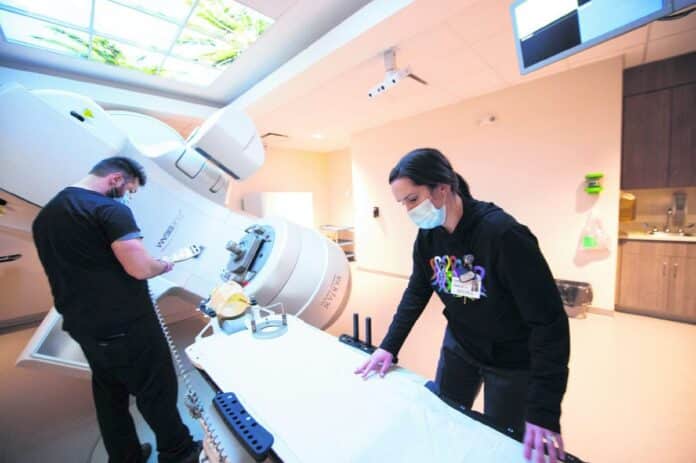
GREENFIELD — A new radiation treatment at the Sue Ann Wortman Cancer takes precision to a whole new level.
Thanks to new equipment purchased by the Greenfield center late last year, some cancer patients can now receive radiation in a much more precisely targeted area of tissue — as small as a millimeter in diameter — compared to previous treatments that could pinpoint down to one centimeter.
The new technology — known as stereotactic radiosurgery, or SRS — pinpoints radiation delivered through the cancer center’s linear accelerator machine using cones through which the radiation is focused.
[sc:text-divider text-divider-title=”Story continues below gallery” ]Click here to purchase photos from this gallery
It can treat tiny areas in the brain and spine in a single treatment, which generally takes less than an hour.
Doctors say it opens up a whole new world for brain cancer patients who previously were faced with having their tumors surgically removed or having radiation shot at their whole brain.
The precision focus helps preserve healthy surrounding tissue and causes less extreme side effects than more in-depth, repeated radiation, said Dr. Julia Compton, radiation oncologist and president of the Hancock Physicians Network.
The high-tech treatment is comparable to that found in major hospitals in Indianapolis and other metropolitan areas around the country, she said.
“The technology is not available everywhere, but it is here,” said Compton, who helped open the Sue Ann Wortman Cancer Center at Hancock Regional Hospital in 2015.
Compton said the new local offering is in line with the center’s mission to bring the best technology available to Hancock County.
“One of the pieces we’ve focused on with our cancer center is being able to provide the level of technology that patients can get — very-high quality state-of-the art treatments — right in their backyard,” she said.
The center’s director, Linda Zerr, is thrilled to be able to offer the technology to local patients, rather than having to send them to Indianapolis or elsewhere for treatment.
“We have a solid partnership with all the area hospitals and we refer people to wherever they need to go for their care, but when we can add a service that keeps people close to home and gives them everything in one place, that’s what we strive to do,” she said.
The enhanced treatment will be a game changer for many cancer patients, Compton said.
In the past, patients with brain cancer had to choose between undergoing whole-brain radiation or having the spots removed by a neurosurgeon, she said. The latest technology allows doctors to treat smaller areas than ever before, enabling patients to get back to their lives more quickly.
“As cancer treatments get better and better, people live for much longer periods of time,” Compton said, even with cancers that were once deemed untreatable. “At one point we may have said ‘We’re sorry it’s Stage 4, you have limited time’, but now we’re finding that while it may be Stage 4, we can manage it almost like chronic disease.”
According to Zerr, the American College of Surgeons recently reported that the national cancer death rate dropped 2.4% from 2017 to 2018. It dropped 31% from 1991 to 2018.
“That means more and more people are living longer” thanks to advancing technology, she said.
The latest treatments not only help eradicate cancer, but they help patients get back to their normal lives more quickly with fewer side effects, Zerr said.
The cancer center received the new equipment, consisting of a set of attachments for the cancer center’s radiation machine, in early December. The staff has spent the past several weeks calibrating and testing the new equipment.
“It takes a lot of effort to calibrate it and make sure it’s safe,” Compton said. “We’re talking about something that’s under a centimeter in size, so you want to be 100% positive that if you’re treating something that was 5 millimeters, that you’re treating something that’s only 5 millimeters. The ability to calibrate that takes a good bit of time.”
Hospital officials expect the treatment to be available to patients starting next week.
Compton said the single radiation treatment is generally well-tolerated by patients, although some may experience tiredness for a couple of days afterwards, and a few may experience hair loss in the area of treatment.
The procedure is very different from whole brain radiation, which treats the entire brain, she said, so the side effects are less intense.
Radiation therapist Shelby Kessler said she’s thankful for the chance to offer the less-invasive treatment to patients.
“This is some great technology, especially for being in a hometown-type feel of a community,” Kessler said. “You could go to Indianapolis and get the same treatment, but you won’t get that same hometown feel, so I think it’s a great blessing to our community to have this amazing technology at our disposal.”
While the latest radiation technology is impressive, Compton has no doubt it will continue to be enhanced in the future.
“Right now, the level of accuracy is about 0.1 centimeter, or one millimeter, but it can always get more focused,” she said. “Can they refine that in the future? Absolutely. Everything continues to get more and more and more precise as the technology develops.”
Steve Long, president of Hancock Health, which oversees the cancer center, said the enhanced treatment will also allow the center to treat more patients each week.
“It allows us to adjust our services to treat more patients here at the local level, without sending them out somewhere else,” he said.




